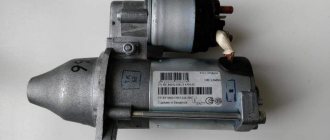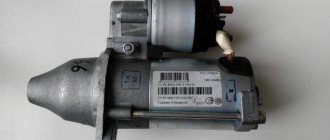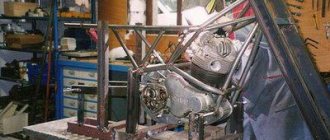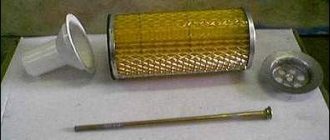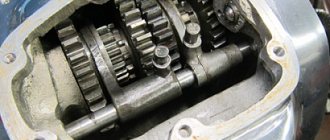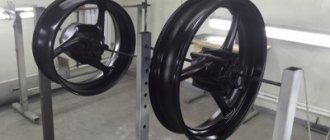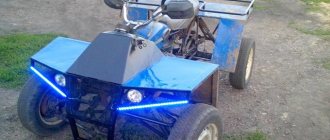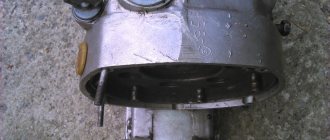Fans and simply owners of Ural motorcycles own not just a means of transportation, but a thing that shaped an entire generation of bikers. Alas, age makes itself felt and it manifests itself in unpleasant little things. This can be considered the absence of a starter. The problem is not critical, but it causes some inconvenience. Craftsmen who began to adapt a starter from a car to their bike helped solve the issue. Today we will tell you how to install a starter on a Ural motorcycle with your own hands.
Installing a starter on a Ural motorcycle with your own hands
Fans and simply owners of Ural motorcycles own not just a means of transportation, but a thing that shaped an entire generation of bikers. Alas, age makes itself felt and it manifests itself in unpleasant little things. This can be considered the absence of a starter. The problem is not critical, but it causes some inconvenience. Craftsmen who began to adapt a starter from a car to their bike helped solve the issue. Today we will tell you how to install a starter on a Ural motorcycle with your own hands.
Why do you need a starter?
Some models of modern motorcycles are equipped with starters due to the lack of a crank. Here, the presence of a starter is assumed initially. However, in other cases it serves only for the convenience of the rider. There is no need to practice every time before a trip, especially if the valves or ignition are not adjusted.
The Ural, due to its archaic nature, did not even imply the installation of a starter. At the time of the release of the first motorcycles, the starter was a luxury that a Soviet citizen could not afford, and then the design was preserved because of its reliability.
Installing an electric starter on a Ural motorcycle will save you from an overinflated right leg and sudden injuries to the kneecap, so the procedure can be considered as simplifying the life of the rider.
Selecting the ring gear and starter
First of all, we pay attention to the flywheel of the motor, it is the key for further work. Its rotation, when viewed from the gearbox, occurs counterclockwise, which means you need to select a starter that rotates in the opposite direction (clockwise). Here are the models that suit us:
It is also possible to install a starter in the Urals from a number of models suitable for imported cars. The problem with such starters is their high cost, which also applies to modern VAZ car models. Here, choose for yourself what is your priority - the cost of the part or the service life.
Pay attention to the presence of the casing and its orientation. The method of fastening the part and further ease of maintenance will depend on this parameter. Rotating the starter relative to its own axis is not advisable and can lead to its breakdown.
Now you need to pick up the crown. The crown is a gear lining on the flywheel that transmits the rotation of the starter to the engine through a gear transmission. The problem is that purchasing the part is quite problematic. A spare part from the Buran snowmobile, as well as more modern domestic motorcycles “Voyage”, “Cobra”, “Wolf” can be suitable for the size of the flywheel. The size of the teeth of the first ring is 2.5, and the modulus of the last three is 2.2. This parameter must be related to the starter module.
If the modules do not match, there are several options to solve the problem:
- We change the starter ring/gear to one that matches the module.
- We adjust the teeth of the existing starter ring or gear to the module.
- We make the starter ring or drive gear from scratch.
Handy tools and tuning of the Dnieper for sports
Tuning the Dnieper for sports primarily involves installing a plastic cladding. In the absence of special cladding panels and panels, the cladding can be made from a foam plastic model. Cheap and abundant material allows you to worry-free experiment with the design of the unit until the best option is found.
After cutting out the model, the foam is coated with a layer of liquid that prevents the fiberglass from sticking to it. The latter is cut to size, soaked in epoxy resin and applied in 4-5 layers to the foam. During the first two layers, it is recommended to add metal shavings to the resin, and, if possible, place a thin metal mesh between the fiber and the foam to strengthen the frame.
To completely dry the structure, you need to wait about a day, after which the foam can be removed. The resulting cladding is puttied, sanded, primed and painted. Painting in most cases is done in bright shades of blue, green, yellow, and red. Airbrushing is not uncommon, and it is performed entirely depending on the owner’s imagination.
Just as in the case of a chopper, tuning for sport involves changing the frame design, only in this case without lengthening or significantly tilting the front fork. A high “rocket” rear fender is installed, and the recessed seat is made to slope towards the high gas tank. The handlebars are shortened to an extremely comfortable length, and the exhaust pipe rises at an angle equal to the rear fender.
Starter fastener
First of all, we determine the place of attachment of the element. The most popular is the upper left side above the flywheel. In this case, we will only be faced with the need to cut out a window for engaging the starter gears. It is difficult to install the starter in the center or on the right side, due to the need to redo a number of engine elements.
For installation, a hole is cut out under the Bendix casing. Next, measurements are taken, and the starter mount is cut out of a 4mm thick sheet of steel. This thickness is necessary to withstand the loads that the fasteners experience during operation of the starter mechanism. In a similar way, you can make not one solid, but a pair of fasteners. This way you can simplify the process of making fasteners, but adjusting the gaps will become much more difficult.
Advice. For greater solidity of the structure, it is best to secure the starter tail rigidly to the motor or grab it with a clamp.
The finished plate is secured with bolts or pinched with argon, then a trial assembly is carried out. Now you need to make sure that the gaps are set:
- the gap between the flywheel gear and the roller clutch is 2-4 mm;
- between the bendix and the crown is 3-7 mm.
Next, the flywheel is rotated, observing the coincidence of the pitch of the bendix and the ring. In this case, rotation of the flywheel is ensured using a kickstarter. Once you are sure that everything is working as expected, you can perform a test turn by unscrewing the spark plugs. If the starter rotates the flywheel without any extraneous sounds, then the plate can be permanently welded with argon.
Important! Welding of the gearbox housing is possible only after dismantling all rubber parts, installing the primary and secondary shafts and securing the cover with 4 bolts.
Symptoms and causes of malfunction
Due to difficult access to the flywheel, visual inspection of this gear of the gearbox is difficult, so car owners remember about it with the following symptoms:
- problems starting the engine;
- jerking, grinding and extraneous sounds when the bendix engages the flywheel.
Engagement of the ring gear with the starter
The reasons why teeth wear out are:
- defects in the manufacture of the flywheel - overheating of the toothed rim during landing leads to tempering of the steel, a decrease in strength, and an increase in the ductility of the structural material;
- non-parallelism of the axes - the gear ratio is very high, any deviation of the axis of the starter shaft from the axis of the crankshaft will lead to the development of a tooth involute on one side;
- violation of the tooth profile - over time, the transmission elements wear out, at the moment of gear engagement/disengagement, the profile is cut off completely;
- lack of lubrication - due to the design features of the transmission, it is physically impossible to apply lubricant to the bendix and the flywheel crown.
Tooth wear
In any of these cases, it is recommended to replace the flywheel crown. In some cases, bedix can grind off only part of the tooth from the outside, so it is enough to change the sides of the crown.
Battery and alternator problems
After installing the starter on a Ural motorcycle with your own hands is completed, a couple of unresolved problems remain. First of all, a car starter requires a more powerful battery. The way out of the situation is to install an inexpensive battery on a new mount (from the side of the motorcycle. Everything will look quite rough, but it’s inexpensive.
Another way is to select an imported battery of a similar size with an increased capacity of 18 A/h. You will have to overpay quite a bit, but the appearance of the motorcycle will not suffer.
Finally, it turns out that the original generator is rather weak and is unable to charge a new battery. We’ll answer right away that rewinding will help increase productivity, but it will not be enough for our purposes. What should we do then? There are several options:
- generator from IMZ. There is a cheap model 14.3771, which fits perfectly, even without modifications to our motorcycle. Its biggest drawback is its terrible build quality. The generator often fails. The solution is modern models of the DENSO brand, which are equipped with these motorcycles.
- imported car generator. The problem here is its installation. If you choose to extend the shaft and install it through a faceplate, please note that all work must be performed with high precision. Also, such generators can be installed using a belt drive. The method has a lot of advantages, especially its unpretentiousness. All you need to do is monitor the condition of the belt and check the cavity of the generator cover for dirt every 10–15 thousand.
The disadvantages of such a modification are decreased engine power and increased shaft load. On the other hand, power can be increased in other ways, but engine load cannot be avoided.
Body and frame tuning
Its appearance will largely depend on how the frame base on the motorcycle is redone. At the present stage, there are several popular ways to remake the Dnepr frame.
Regardless of the modification of this bike, all models have a similar frame design.
You can extend the frame at the rear of the motorcycle. This tuning involves adding 15-20 centimeters to the frame, which increases the space for the rider’s legs. When the frame is lengthened, the driveshaft also lengthens, and the adjustment of the distance by which the frame should be lengthened depends on the height of the driver. If you lengthen the frame in the front part, you can achieve a landing similar to classic American choppers, while you do not need to change the driveshaft, but you will have to redo the pedal arrangement.
The frame is also expanded. We are talking about installing a more powerful rear wheel. To do this, an additional gearbox is installed on the cardan shaft, which will shift the cardan output to the side. It is best to install wheels with a profile of 130-150 millimeters, this way you can achieve optimal ride quality from the bike. A tire that is too wide can add certain difficulties to the driver.
When changing the angle of the front fork, experts recommend increasing the angle of inclination by no more than 35 degrees, otherwise the handling of the motorcycle will be seriously affected. In addition, an increase in the angle of inclination is accompanied by loads on the “stays” of the front fork, which leads to their rapid wear and failure.
Changing the angle of the rear shock absorbers will provide a more aesthetically pleasing appearance for the motorcycle, however, as with the front forks, too much angle can result in a loss of load-carrying capacity to the point where even single-passenger riding becomes impossible.
Effortless: installing an electric starter on a motorcycle
Starting a motorcycle with a kickstarter can require a lot of effort, which is why many owners of domestic equipment often abandon it in favor of inexpensive foreign analogues. However, Russian motorcycles have their advantages, represented by ease of tuning, low cost of spare parts, as well as low sensitivity to fuel quality and the reliability of most components. That is why experienced owners of two-wheeled domestic vehicles often install an electric starter on a motorcycle - such an operation can make the Ural or Dnepr much more convenient. This also applies to small-capacity budget-class foreign motorcycles, which are also often equipped only with a kickstarter. Let's look at the procedure for installing an electric starter using domestic technology as an example.
Selection of parts
The best option is electric starters from the Kherson plant, which are used in tractor starting engines, as well as in small-class boat engines. However, you need to be very careful in choosing components - components marked ST353, 367 or 369 are suitable for the Ural. You should not purchase the ST366 starter, which was installed on the Zaporozhets - it has a reverse direction and a different shape of the Bendix casing, incompatible with a motorcycle engine . For such an electric starter, you should purchase a crown from the Buran snowmobile - it requires only minimal modification. Be careful - you need a unit with a top-mounted retractor relay, since, being located at the bottom, it will interfere with changing the oil in the engine.
It is also possible to install an electric starter from a VAZ-2109 car or a more modern unit from a VAZ-2110, but in this case you will have to make the crown yourself, using a professional metalworking machine. To create a spare part, it is better to use steel grade 40-X or another that meets the hardness standard 35-42 HRC/E. For imported motorcycles, the electric starter must be selected especially carefully - many owners of two-wheeled equipment say that components from industrial generators or powerful garden equipment are a suitable option. However, you will definitely have to grind the crown for the starter yourself, since unification is a distinctive feature of domestic motorcycles.
There are several options for attaching an electric starter to a boxer motorcycle engine:
- More powerful and longer gearbox studs are made, after which a duralumin plate with a pre-drilled hole with a diameter of 76 mm for the unit casing is put on them. This option is rarely used due to its low strength and negative impact on the service life of the electric starter;
- A composite mount in the form of two crescents is made from duralumin, which is welded from below to the gearbox housing. Be careful - during the argon welding process, all rubber elements of the transmission must be removed, but the shafts and covers should be left in place, since their absence can cause serious deformation of the crankcase;
- A solid duralumin plate is made and welded to the gearbox casing. The bad option is that it forces you to completely remove the contact oil filter, disrupting the normal operation of the transmission.
On foreign motorcycles, installing a starter is complicated by the lack of serious developments in this area. Therefore, you will have to show some engineering savvy and make an appropriate mount or adapter plate that will not interfere with other components.
Before installation, you need to carefully sand the surface of the electric starter stop with a grinding machine to achieve a perfect fit of the part. To properly secure the starter flange, you need to remove the solenoid relay, and also move the bendix fully forward to understand what its operating position will be. The unit is fixed using a flange, after which it is necessary to check the tightness of its fit and the stability of the position. Now you need to set the optimal gaps that will allow you to achieve stable operation of the device.
Between the gear located on the starter and the flywheel ring, you should leave a distance of 5–7 mm - to set it, you can use foil folded many times. You also need to leave a gap of 2–4 mm between the ring and the roller clutch, which is located immediately behind the gear. It should be measured in the rest position, and not in the operating state of the starter, which will allow the unit to achieve stable operation. If you purchased a used starter, make sure that its bronze-graphite bushings are not worn out and also match the diameter of the axle shaft - otherwise the reliability of the part will be significantly reduced, and starting the engine will be accompanied by unpleasant sounds.
When the starter position is set, it must be removed in order to finally weld the flange to the gearbox housing. You can do this yourself, but you will need equipment for argon welding. Make sure all the parts are in place and start working. Remember that after welding the metal must cool on its own, since its forced cooling will lead to a significant decrease in the strength of the joint.
After the metal has cooled, assemble the starter on the flange and make sure that its gear does not move away from the ring even under fairly strong loads on the assembly body. Now you can connect the electric starter to the battery - during operation it should create a monotonous sound, and also rotate the gear without blocking or braking. In addition, it is worth checking how easily it engages and disengages with the crown. Unfortunately, installing an electric starter may interfere with the operation of the engine start pedal. Since it is not advisable to completely remove it, it is better to simply change the shape of the part, while maintaining a backup method of starting the motor.
Replacing the crown
Since the toothed rim is pressed onto the flywheel disc, it cannot be removed/put on without heating. The main problems with self-repair in this case are:
- the car owner does not have special equipment - they use burners, blowtorches and even heating a gas stove in the oven;
- the temperature of the crown is difficult to determine - heating is done “by eye”;
- technological requirements - the toothed rim should be heated to 200 degrees, but without special devices it is very difficult to maintain the temperature.
To increase the strength of the steel, the gear rim is hardened at the factory. It is not recommended to heat hardened parts, since in this case the crown is automatically subjected to another heat treatment - tempering. The performance characteristics obtained during hardening - hardness, wear resistance of the structural material - change into the opposite properties of the metal - toughness and plasticity.
In other words, if you overheat the rim, after putting it on the disc and cooling in the air, the teeth will become softer and grind off much faster. There are three types of leave:
- high - heating to 450 - 600 degrees to obtain a sorbitol steel structure;
- medium - heating to 300 - 450 degrees to obtain a troostite steel structure;
- low - heating to 150 - 300 degrees to obtain a martensite structure.
When overheated, the structure of the metal will change
Dismantling
The crown has no additional methods of fixation other than an interference fit on the flywheel, so it can be removed quite easily, even without heating:
- the part is placed on stands so that the toothed rim hangs down;
- uniform blows are applied with a hammer around the circumference of the crown.
Removing the toothed rim
If the toothed rim is definitely rejected for replacement, you can knock directly on the teeth. When the crown is rotated 180 degrees for further operation, the blows are applied through the gasket - a second hammer, a chisel, a piece of reinforcement.
Ring gear selection
Before replacing the flywheel crown with a new consumable part, it is necessary to select a complete replacement:
- centrifugal forces tend to rupture the disk during operation;
- the flat surface against which the clutch is pressed is distorted;
- friction of the linings on the flywheel causes heating, further increasing the warping of the plane.
After an interference fit, the toothed rim tightens the flywheel disc, eliminating the above defects. In addition to increasing the service life of the flywheel, the service life of the car’s clutch increases.
All of these design features are present in the rims manufactured by Tanaki. The number of teeth must match initially. In internal combustion engines of some manufacturers, the flywheel is used as an element of the DPKV crankshaft position sensor. In this case, two teeth on the crown are missing; before dismantling, it is necessary to create a mark of the relative position of the area with the missing tooth relative to the disk.
Installation
You can mount the crown of a car flywheel without heating only when turning it. However, even in this case, there remains a risk of the rim turning relative to the disk during operation, so after installation this part is secured by welding at 4 points.
Methods for heating the crown
The main heating methods when installing the crown on the flywheel are:
- oven or burners of a gas or electric stove - it is very difficult to overheat the part, you will have to turn it periodically on the burners;
- blowtorch or gas torch - it is necessary to control overheating visually, preventing the toothed rim from changing color.
Heating on an electric stove
Heating with a gas burner
In any of the above options, the flywheel disk must be in close proximity to the place where the rim is heated in order to install it on the seating surface as quickly as possible using pliers, pliers or hands wearing special heat-resistant gloves.
After cooling, the part will shrink on its own; if necessary, tacks are used at several points.
Flipping the old rim
To turn over the flywheel ring in use, you need to knock it off its seat, turn the disk over, and put the heated rim in its place. If at the factory or during subsequent replacement this element is put on with the chamfer inward, then when turned, the chamfer automatically remains on the outside.
Tooth rim revolution
Additional work
Since the standard electrical system of the Ural motorcycle, as well as the circuit of most imported vehicles, is not designed to operate equipment with a starter, modifications will have to be made to it. At the slightest drop in ambient temperature, starting problems may arise - the starter will quickly discharge the battery, which will force you to recharge it and subsequently use the pedal. Experienced motorcyclists recommend installing a battery from a Japanese car from the 90s on a two-wheeled vehicle. This battery has compact dimensions and a fairly large capacity - up to 65 Ah.
Spectacular bike
To create this masterpiece, a resident of Bashkortostan decided to attach a car wheel to a motorcycle. Parts from various vehicles were also used in the restoration.
The front brakes and fork came from the IZh Orion, the carburetor from the VAZ-2106, and the ignition from the Oka. After the repair, the motorcycle turned out to be impressive, its length was 2720 cm.
From the old Dnepr, only the gas tank and engine remained in the restored model. This motorcycle was restored back in 2007.
Heavy KMZ motorcycles have become famous for their strength and durability, which now remain their main advantages. These models do not allow enthusiasts to forget about the legendary technology and create unique cars on its basis.
DIY tuning
The starter installation procedure described above requires fairly good skill and special equipment. Therefore, if you do not have an argon welding machine or a lathe, you should find out in advance where you can use the services of professionals of the appropriate profile. All manufactured fastening parts and gears must have minimum tolerances, since the reliability of the installed electric starter depends on this. The starter itself must be in good technical condition - to make sure of this, it is worth checking the bushings and shaft. If all these conditions are met, the electric starter will serve you for many years, providing maximum convenience for starting your motorcycle engine.
Finishing
When the starter position is set, it must be removed in order to finally weld the flange to the gearbox housing. You can do this yourself, but you will need equipment for argon welding. Make sure all the parts are in place and start working. Remember that after welding the metal must cool on its own, since its forced cooling will lead to a significant decrease in the strength of the joint.
After the metal has cooled, assemble the starter on the flange and make sure that its gear does not move away from the ring even under fairly strong loads on the assembly body. Now you can connect the electric starter to the battery - during operation it should create a monotonous sound, and also rotate the gear without blocking or braking. In addition, it is worth checking how easily it engages and disengages with the crown. Unfortunately, installing an electric starter may interfere with the operation of the engine start pedal. Since it is not advisable to completely remove it, it is better to simply change the shape of the part, while maintaining a backup method of starting the motor.
Source
Installing a starter on a Ural motorcycle with your own hands
Equipping a motorcycle with a starter in most cases is determined by the owner’s desire for convenience and practicality, less often - by urgent need. In some cases, for example, when the technical feature of the unit does not allow it to be equipped with a crank, installing this module is the only way out.
A starter is an electromechanical device designed to start an internal combustion engine. The device is a powerful mixed-excitation electric motor powered by direct current provided by the on-board battery.
Choosing a starter
Before installing an electric starter on a Ural motorcycle, you should familiarize yourself with the technical parameters of the motor of this vehicle. The latest models of the two-wheeled legend are equipped with a four-stroke flat-twin engine with a displacement of 745 cm3 and a power of 40 hp.
For installation, both on the specified engine and on other creations of IMZ and KMZ, models ST-353, ST-367, ST-369 or “donor” ones from VAZ 2109, 21099, 2110 and 21011 are most often used. Their characteristic feature is rotation of the drive clockwise, widespread and low cost. This component can also be taken from foreign cars (Skoda, Mitsubishi, Toyota, etc.), but due to the relative high cost, their use is less common.
You should also pay attention to the crown of the device. If its diameter or tooth pitch differs from what we need, then this part must be modified. Its implementation is achieved by disassembling the starter and removing the axial shaft with the gear attached to it. The teeth of the latter are ground off, while the inner part remains intact. The inside diameter of a suitable gear is bored enough so that it can be pressed onto the outside of the ground part. After pressing, both components are welded, and the seams are ground together.
Selection options
An electric starter in the Urals is installed after all the technical characteristics of the vehicle have been determined. Often, car enthusiasts take advantage of the opportunity, if available, and introduce models from a donor car - the VAZ 2109 and its modifications.
Read also: Do-it-yourself log house. Benefit
You can use a product from other foreign-made machines, but it will cost a little more. When choosing a part, you should also take a closer look at the crown of the device. If the diameter and pitch of the teeth do not meet the requirements, then you need to disassemble the structure of the device and remove the axial shaft with gears. Its teeth are worn down. The diameter expands from the inside so that it can be pressed onto the front side of the ground part. Then they are welded to each other.
Installation process
Assembly drawing of the electric start system:
- starter mounting part;
- crown;
- starter;
- clamp;
- starter rear mounting bracket;
- flywheel.
Do-it-yourself installation of the starter on a Ural motorcycle is done at the gearbox (often in the upper part). Installation can also be done on the left side , but in this case you will have to sacrifice the kick starter foot, or reconsider its design.
The first step is to mark the sample of the starter housing and gearbox. Then cut out the marked areas using a grinder or milling machine. Among the possible options for mounting the starter, the three most popular are:
- Using a solid steel or duralumin plate. Purchased or made independently, it must have a central hole and fastenings to the engine housing. The standard gearbox fixing spokes are replaced with elongated ones. When installing a starting device with a plate, washers and nuts should be selected of such thickness that when turned on, the bendex gear fully engages with the flywheel ring and similarly comes out of the clutch when turned off.
- Using two separate or one continuous (semi-monthly) lower duralumin clamp welded to the gearbox. In this case, to avoid deformation, all rubber parts from the gearbox housing must be removed.
- A solid duralumin plate is secured with 2 bolts and welded to the gearbox housing.
With any of these types of fastening, the load on the connecting plate is removed by fixing the rear of the starter to the motorcycle body. Next, with the device attached, the gaps are set for both the roller clutch with the ring and the ring with the starter gear.
What is the design of the gear-six starter?
The VAZ 2106, produced after the 1980s, has a starter with an end manifold model 35.3708. Earlier cars from the Volzhsky plant had a different gear mechanism installed - ST-221, which was equipped with a cylindrical manifold. Their structure is approximately the same, so they are completely interchangeable.
Let's take a closer look at the design of the mechanisms that interest us, using model 35.3708 as an example. The “six” gear starter consists of the following main parts:
Read also: 110 Interesting facts from geography
- field winding (i.e. stator) and housing;
- electric drive with anchor;
- three special covers;
- electromagnetic traction relay with two windings (one of them is retracting, the other is holding).
Using bolts, the starter housing is secured into one block with three covers. The armature of the mechanism we are interested in has a core, a commutator and a shaft. The last of these elements rotates in metal-ceramic bushings (there are two of them structurally provided). These bushings are pressed into the covers and must be impregnated with a lubricant. The starter drive is located at the end of the shaft. It includes a gear and a roller clutch, which is necessary to transmit torque to the flywheel.
On the front cover there is a relay consisting of a yoke, several flanges and a core. When the gear mechanism is turned on, two processes occur simultaneously: the armature is retracted, and the drive and gear mesh with the flywheel; a special contact plate closes the bolts. The result of these processes is the start of power supply to the windings of the device we are considering. As you can see, the circuit for switching on and operating the “six” starter is quite simple.
Electric starter
Well, I finally started writing this post. I’ve long wanted to install an electric starter on my Bolivar, but either I’m not up to it, I don’t want to disassemble the engine, and during the rebuild I want to quickly assemble it and drive it. However, after an unsuccessful trip to Rostov, on the birthday of the Olen bike house, when I turned the crankshaft in Yaroslavl with all the consequences, I decided to finally give myself an electric start during this capital campaign. Despite the fact that the Internet is full of articles on this topic, they are all quite vague, plus I have not seen a single video where a “live” 650cc Ural was started with an electric starter. No, the video is complete, but they show some intermediate stages, like: “here I attached the starter, here I connect the wires to the Akum and it seems like something is turning, but the engine is still half disassembled.” Somehow I got distracted, closer to the topic.
In order to install an electric starter, you need to buy a ring gear for the flywheel. Someone is remaking a crown from Buran (in my opinion), but I took a ready-made one, which is installed instead of the last clutch disc.
Ring gear
Together with the ring gear, a bracket for mounting the starter on the box was purchased. There are two such brackets, on top of the box and on the side. But, since I have a Ural gearbox, and the starter from the side looks, in my opinion, much more aesthetically pleasing, my choice fell on the side mount.
Starter mounting bracket
A tens starter with a 9-tooth Bendix was recommended as a starter. But I had a starter from Oka lying in my garage, which, as it turned out, is almost identical to the ten starter, the only difference is in the starter cover. After going around several auto parts stores, I finally found the cover I needed, so with a slight movement of the hand (and unscrewing a couple of screws) the starter from the Oka was turned into a tenth starter, and at the same time, preventive maintenance was done and the gearbox was lubricated.
Starter from Oka
Difference in starter caps
The starter we need
Then the fun begins. Using the starter mount as a guide, a window is marked on the engine crankcase and gearbox, after which it is roughly cut out (not to size, of course), followed by a file adjustment to the required dimensions.
Example window
After that, only the ring gear was placed on the flywheel, the flywheel was attached to the crankshaft, a mark was made on the crankcase (taking into account that the flywheel would sit deeper) where the ring gear ends and the flywheel begins. A mark was also made on the starter cover where the bendix ends if it is pulled out to the end, after which the flywheel was removed and the holes were adjusted to finish.
Estimation and final hole
The centering bosses had to be cut off from the box housing, otherwise the ring gear would rest against them. I had to disassemble the air filter and cut off part of it so that the starter could fit into place. We also made two box mounting studs, which had to be made larger due to the fact that now the starter was also attached to them.
After that, the flywheel and clutch assembly was finally installed on the crankshaft, the engine and gearbox were assembled, and the starter was roughly put in place. After fitting, there were small tests to see how the starter turns the flywheel, whether the teeth are torn off, whether there is any misalignment, etc.
Starter fitting First tests
After I was sure that everything was going well, bushings were made to secure the starter at the required distance and at the same time press the box.
Once the starter was finally secured, a second test was carried out to ensure everything was going according to plan.
Second tests
After this, the final stage of engine assembly began. Since there is no air filter now, I temporarily installed zeros. In the future I will install a starter filter from KBMTS.
Final view of the engine
Starter filter
Well, now, actually, the finale. That's what this whole post was all about. Video of starting a Ural 650cc motorcycle using an electric starter. Engine just after rebuild. New crankshaft from Soviet stocks, aluminum cylinders, AT 78mm pistons, new heads. The video shows the second launch. I didn’t film the first launch, but it started up almost immediately, after which I let it run for 10 minutes, turned it off and decided to make this video. Enjoy!
Starting with electric starter
The gearbox housing of the new Urals and the insides of the old one - how realistic is it?
Greetings. It is possible to take a gearbox housing from a modern Ural for a starter. In terms of fasteners and dimensions, the crankcase coincides with the old gearbox. From the photo, I certainly saw some differences in the case. The question is this. How realistic is it to transfer ALL the internals from the Economic Council checkpoint? Will there be any problems? Or is it still more advisable to mutate the starter from the old gearbox?
If I’m not mistaken, the interior from the Economic Council could have been placed in the box from the voyage (the one with direct 4)
I read it somewhere here myself, but in my opinion it was written about shafts. Let's say the shafts can be thrown over, but what about the other mechanisms, about the rear speed? For example, I saw that the kick starter spring starts differently and most likely a different spring is needed, and here is the photo.
the reverse speed on the voyage box can be set by drilling a couple of holes similar to those on the Economic Council, someone did this. and this is a more modern box body; if I’m not mistaken again, you can put dukes in this one. I have the same wolf one.
About six years ago I bought a gearbox housing, the one in the photo. I had a box 8.103.10 with zx. This is what I started from. The shafts stood up as if they were original, a hole was drilled under the gearbox activation mechanism and an oil seal was installed (the boss is ready, you can see it). To secure the gear shift shaft, two bushings were machined - one is simply an aluminum boss, inserted after installing the shaft from the side of the manual gear shift lever. The other is a bracket, a bushing for the shaft diameter with a welded plate with two holes. Above in the photo these holes are highlighted on the lid where the bracket is screwed. For some reason my original gearshift shaft didn’t fit, I don’t remember why. I installed the shaft, it seems, from a box from 72 or 62. The issue with the kickstarter spring has not been resolved to this day. I can't find Wolf's one anywhere. But, theoretically, you can take the Dnieper, stretch it a little and bend one whisker to the side. Minus the kickstarter, the box has been quietly working for several years.
In short, this crankcase is hemorrhoids! Somewhere in the year 09, I got the idea to transfer the offal from the 8.103.10 gearbox into the body of such a box in order to install a starter. I bought this very case and it began. No, I assumed that I would buy the missing parts later. Which one is it! The shift bracket and sector lock are hard to find during the day, not to mention a spring. I swore, I remember! And even now I have an unkind word for IMZ workers who don’t bother to put components for their works on sale. So the case with the back cover lay idle for several years until I sold it this spring.
what is there, besides the kickstarter spring, so crap!? Make a simple bushing and weld it to the plate? Spring yes, bad luck! Indeed, such a “trifle” could be thrown onto the market.
Well, the bracket, whatever, it’s not difficult to make. But look for the sector locking lever together with the spring, there is also a tricky bearing on the gearbox foot - look for it, look for the cover and bushing of the shift axis - look for it or muddy it yourself. Few? Well, maybe, but when I poked my head around all the hot spots selling spare parts in the Urals, they looked at me with round eyes, saying, what are you saying, these spare parts haven’t been around for a long time, what are you talking about?! After this you even feel somehow inferior. And then recently I had to find a valve for 750 Volkov heads. It would seem, what could be simpler? But to hell with it, there is only a kit of American ones with 7 mm. rods at a hefty price and replacing just one (I needed to change 1) would have resulted in hell. Fortunately, they advised me to install it from Dnepr :)
Source
